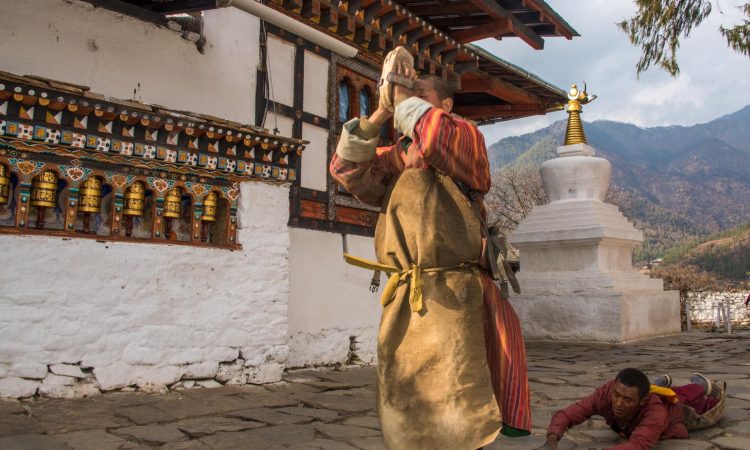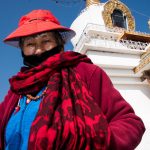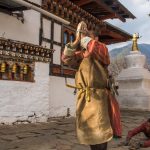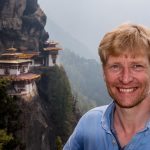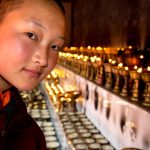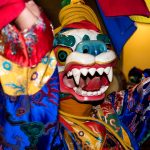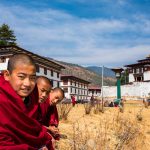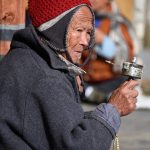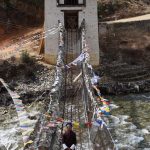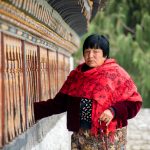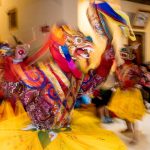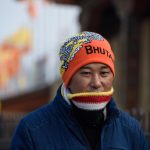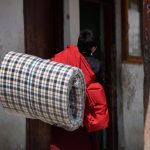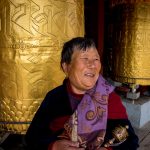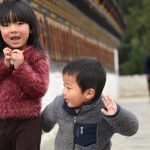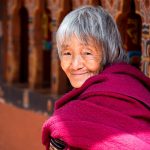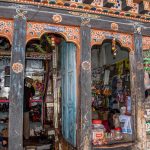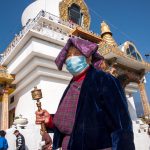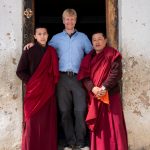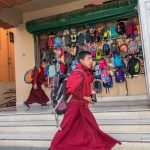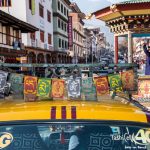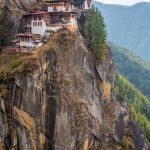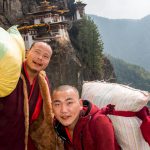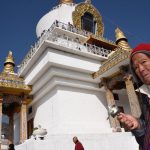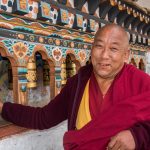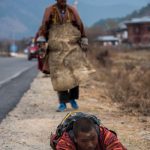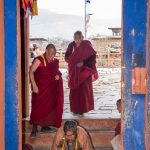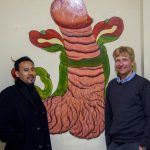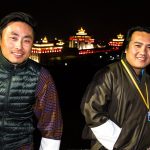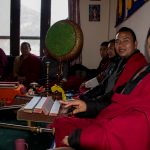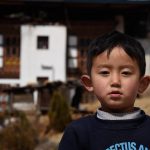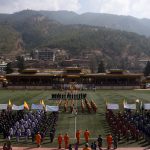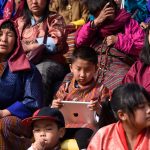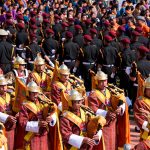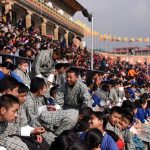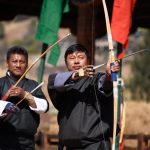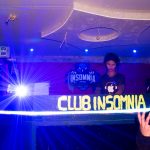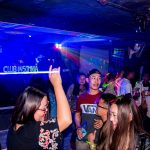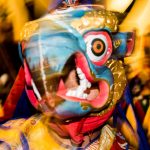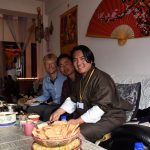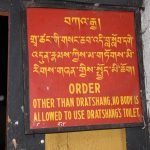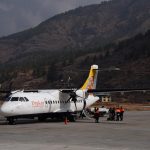Land of the Thunder Dragon & Kingdom in the Sky – or how I saved my penis from being plunked
The small 48-seater propeller plane smoothly navigates through the morning mist that hangs low and surrounds the almost 5.500-meter-high Himalaya mountains. The international airport in Paro is known as ‘The world’s most difficult international airport’. It is only navigable in daylight hours and planes are often cancelled or delayed due to rain, fog or snow. Only pilots from the national carrier Druk Air, the private carrier Bhutan Air or from the Nepalese carrier aptly named Buddha Air can take-off or land in the airport. Fortunately, our pilot seems totally unaffected by these facts as he smoothly circumnavigates mountain after mountain before finally landing deep down in the Paro valley at an altitude of 2.235 meters above sea level.
Bhutan is only accessible to those who have bought a package tour. Three months before arrival I paid a total of 920 USD for a 5days/4nights “Free Independent Traveler” trip around the Paro/Thimphu region including meals, hotels, transportation, driver and guide.
When I land in the ‘Kingdom in the Sky’ all I know is that I am being picked up by my tour operator Bhutan Majestic Travel. I have no idea where I am going to stay. No idea what I am going to see. I have been so busy planning the rest of my one-month trip that I have had no time to even ask about this. I am not even sure that I am the only tourist in my group.
In the airport I am met by Loday and Sonam. ‘The intelligent one’ and ‘the lucky one’ their Bhutanese names mean. Both are they wearing a Gho the traditional male national dress featuring knee stockings, leather shoes with laces and a gown with white silk roll-up sleeves called “Lagay” symbolizing honesty and trust in the country. Loday welcomes me by sweeping a “Kadar” around my neck – a white scarf signaling purity. Loday is my guide. He has an iPhone 7+ so I am figuring he cannot be the poorest of guides. Sonam is my driver. A cool, tall and slender guy. ”Do you also have an iPhone 7?” I ask him. “Only if I sell one of my kidneys” he coolly replies. They are both in their late twenties (both are 27 or 29 years old depending on use of the Bhutanese or the Western calendar). As expected I am the only member of my group so apart from being escorted by my very friendly driver and guide I am as advertised a “Free and independent traveler”.
“We have never had a guest arriving before who never asked for an agenda”, Loday informs me. “But don’t worry – we will make a cool program for you”. Time will show that he couldn’t be more right.
On smooth but winding mountain roads Sonam confidently completes the hour-long drive to the capital city of Thimphu in his modern KIA SUV. Almost all houses are new but built in the old Bhutanese style. Cars are also rather new and everything seems surprisingly modern and civilized. Much more so than in Nepal. “We have no beggars” Loday says “and no unemployed. If you do not have other work the state will give you a piece of land and you will have to farm that”. Still it is an exotic place. Most people – men and women – are wearing national clothes. The woman dress-like costume is called a ’Kira’. At Thimphus most busy intersection a policeman in white gloves directs traffic from his traditional hexagonal booth. “We do not have a single traffic light in the whole country” Loday says.
The name of the country – Druk Yul in the local language – literally means “Land of the Thunder Dragon” and the thunder dragon is seen everywhere. Druk School, Druk Air, Druk Gyalpo (Dragon King), Druk Art, Druk Shopping and the national Internet Service Provider is called DrukNet. (In Danish ‘Druk’ means ‘heavy drinking so I have fun photographing as many as possible of them)
The first few days we do traditional sightseeing in and around Thimphu. Fortresses, Stupas and Monasteries. We see the world’s largest published book at the national archives. And we see one of the world’s largest Buddhas (sitting Buddha, 51 meters tall, cost of building estimated 100+ million USD). The largest sources of income in Bhutan are hydroelectric power and tourism and apparently the King/government (democratic elections have been introduced by the present and 5th King) have opted for this significant investment to worship their beloved Buddha.
On my second night in the counry the managing director of Bhutan Majestic Travel has invited me to a traditional restaurant named Orchid. In Copenhagen we always meet “under the giant clock” (at our central railway station) here we meet “under the giant cock” (hehe). Superstition is an important part of Bhutanese culture and a large painted phallus symbol outside a house or a restaurant allegedly should ‘drive away the evil eye and malicious gossip’.
Dinner consists of the national dish Ema Datsi (chili cheese), dried beef with turnips, vegetable soup, Ezay (dried red chili paste with coriander). We drink a sake-like local brew and strong 8% local beers called 11.000. “ ‘One goes. 11.000 comes’ is a local saying if a friend is dumped by his girlfriend” Sonam says with a smile. Namgay – the manager – is a nice, well-travelled and well-educated gentleman and just like Sonam and Loday he makes for very pleasant company.
Not having a set agenda in the end turns out to be my luck. Wednesday February 21st turns out to be the king’s birthday so instead of seeing yet another Buddhistic temple or stupa we spend 5 hours at Thimphu National Stadium watching the Prime Ministers Speech, lots of dance performers in fine dresses and marching orchestras with shining yellow helmets. The Dragon Kings turns 38 (his father abdicated when he himself was 51 years old passing on power to his oldest son – listen up Elizabeth and Margrethe..). The king himself has gone to Paro to visit the Tiger’s nest temple while here in Thimphu the stadium is full almost to the last seat to celebrate him. “Geylo” (power) shouts the Prime Minister. “Pelden Drukpa” (Bhutan independent) the crowd cheerily responds. Entrance is free and everyone gets a free juice delivered to their seat. “Lots of things are free here” Loday explains “Schools, hospitals and even universities if you have the right grades”. Before the celebration ends the Prime Minister goes around shaking peoples hand and the show ends with the “strongest man of Bhutan” competition where tractor tires are carried and logs are divided using an ax. Now and again there is a draw on the (free) entry ticket. The first prize is a plough.
After the stadium celebration we drive to Paro. Loday has invited Sonam and me to his apartment. He says I am the first tourist ever to be invited in his home. What an honor. I ask Sonam if he has been here before as we arrive. “I have picked him up many times here – but never have I been inside his apartment” he replies. Lodays father is some kind of boss in the Bhutan Tourist Association. Maybe that is why the family has two houses – one in west one in east – and an apartment. Loday, however mainly stays in their Paro apartment since it is more central and closer to the airport. In the living room Lodays mother has prepared a feast: Red Rice, boiled and fried eggs, cabbage and broccoli, Ezay (chili paste) and mushroom cheese.For snacks cookies, roasted rice and roasted maize is served. We drink either butter-tea (that tastes infinitely better here than the very harsh butter-tea of Tibet) or sweet milk-tea.
In the adjacent room six monks are performing a Buddhist ceremony (!?). Fruit is sacrificed and long golden horns (called ‘Dungs’) are played. A monk is playing a drum another monk is reading prayers from an extremely wide book and three monks are singing or chanting. In front of them is a sort of alter with a huge artificial penis in the middle.
” Many bhutanese people have this ceremony performed once a year”, Loday explains as if it was the most natural thing in the world to have six monks performing a loud ritual in the next room. Bhutanese people are very superstitious and believe that this will keep away bad luck and secure happiness and fertility in the year to come. The date has not been chosen for being the Kings birthday rather because it “is a lucky day to perform ceremonies according to the Buddhist calendar”. “How do you know which days are lucky?” I ask. “We have an app” (don’t say monks haven’t moved into the 21st century) Loday says and shows it to me. ”Zakar” it is called and for each date it shows if it is a good day to get a new job. A good day for ceremonies etc.
“In the old days a man should have at least 400 cows or horses before he was allowed to have a ceremony performed” I am told. The cows were aligned in a square with 100 cows facing east, 100 facing south, 100 facing west and 100 facing north. “These days the middle class has been allowed to make smaller, private ceremonies if only they can afford to pay the daily fee per participating monk of around 500 Ngultrum (around 8 USD)” Loday explains.
At the end of the ceremony the Penis-figure and lots of other ritual figures are positioned facing out through the front door. Everyone then throws maize and rice at them ensuring that all bad luck disappears when the figures are subsequently thrown out.
At night we go out. We may be climbing a mountain early next morning but that will not stop us. After a traditional dinner (with local 8% beer) we end up at a karaoke-bar where I learn to sing “Alala Alala – Nge gi dunghe – Alala” which means something like “Ouch ouch – my heart is in pain – ouch”. Also, I am taught to say “Par Leshum Top-Chi! – Bum Jarim Ma Thop” – “I got the photo – but I did not get any beautiful girl”. A very useful phrase it turns out. I say it just before portraying the locals with my big Nikon. Almost without exception this brings a smile on their faces. Again the beers come 750 ml bottles do their job efficiently so we decide to move on to a nightclub (Paro has 60.000 inhabitants and no less than 4 discotheques) called Insomnia. “Don’t worry they will close at midnight” Loday says knowing that we must get up at 06.30 the next morning. However when everyone has a three day holiday because of the kings birthday – and when nobody is working discos don’t close early. My head hits the pillow at 2 am – four and a half hours before our ascent towards the Tiger’s nest starts.
Early next morning (day 4) in the morning mist we start our ascent. We have to climb from 2.400 meters city altitude up to the temple in 3.120 meters altitude. According to legend Gury Rinpoche (Buddhist master who in the Himalaya region is known as “the second buddha”) rode up to the temple from Tibet “on the back of a tigress to ‘tame the tiger demon’ and to meditate in a cave”.
While we are on the mountain the weather alternates between fog, sun, rain and snow. Fortunately, the light is ok for photography and I get nice photos of the monastery dramatically situated high on the cliff. An amazing sight and something that should be on any traveler’s bucket list.
Driving back to Paro in the afternoon suddenly we are stopped by eight rather aggressive looking female thunder dragons in the middle of a curved mountain road. Far from kindly they ask for money to let us pass. I chip in 50 Ngultrum (less than a dollar) and Loday does the same. “They are celebrating ‘new farming’“ Loday says. I have no idea what that means. “They mostly target single men. If their targets don’t pay the women will chase them through the fields. Sometimes they will rip a man’s clothes of. Often they will plunk his penis. Throughout the World I have been held up at quite a few road blocks and check points but never before have I had to pay to not have my penis plunked.
After not having my penis plunked we go to Sonam’s house for milk-tea and biscuits. Sonam lives in a renovated, traditional house with his mom and dad. Sonam’s dad is a framer but he used to work for the government with urban planning. One of his three sisters is also present and the two others are on their way there because in three days again the Zakar App tells us it is a lucky day and hence the Sonam family have chosen it for their annual ceremony. “Ceremonies are expensive in Bhutan” Sonam’s dad informs me. “Not only the one we are performing on sunday. For example if a family member dies we must pay for ceremonies 21 days in a row to secure a good afterlife”. They then ask what it costs to die in Denmark. I tell them you need to lease a small piece of land at the cemetery for 10 or 20 years (costing around 10.000 USD). I also tell them about Assistens Graveyard in central Copenhagen where girls sunbathe in bikinis in summer and families are having picnics on top of dead people (for the lack of green areas the cemetery doubles as a recreational garden). They look at me in disbelief. Like it is the craziest thing they ever heard.
At 04.50 am the next morning Sonam messages me that he is on his way to my hotel to take me to the airport. For five days I have been on my “free independent traveler” “group” tour. It feels more like I have seen the country with a couple of friends. A couple of friends who are not overly concerned about limiting their workdays to only eight hours since on our longest day we were together for no less than 17 hours. Friends who have both invited me into their homes and taken me round showing me their extremely photogenic country. Their photogenic country with its calm, hard-working and forever smiling citizens.
(sorry for my bad english I enjoy to write in danish and this is just a quick translation that I made hurriedly yesterday waiting around in airports)
A few more facts about Bhutan:
- Traditional Bhutanese Mask Dance uses the mask of four important animals in Bhutanese mythology: Tiger, Snow Lion, Garuda (half bird half man) and Dragon.
- Bhutan’s national tree is: Cypress
- National Language – Dzongkha
- National flower – blue poppy
- National butterfly – swallowtail
- National Sport – archery
- National Animal – Takin – a rare goat-antilope that is only found in the Himalaya region (also called gnu goat).

